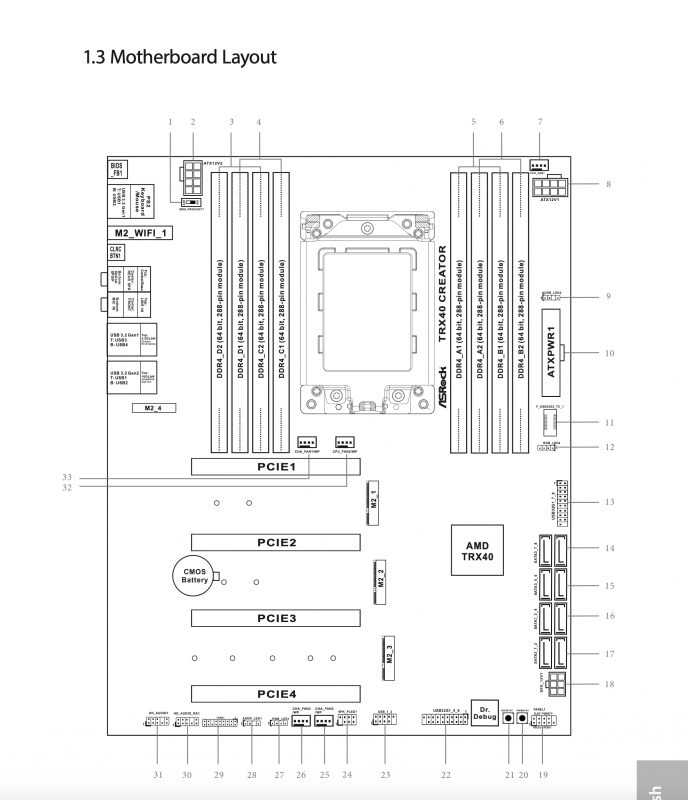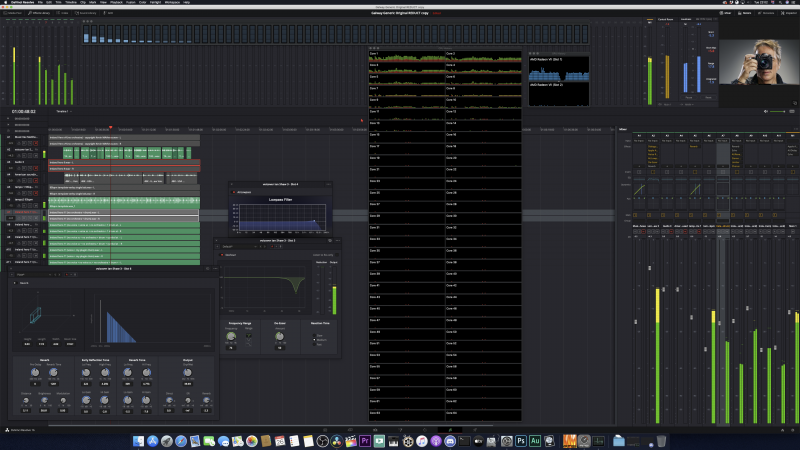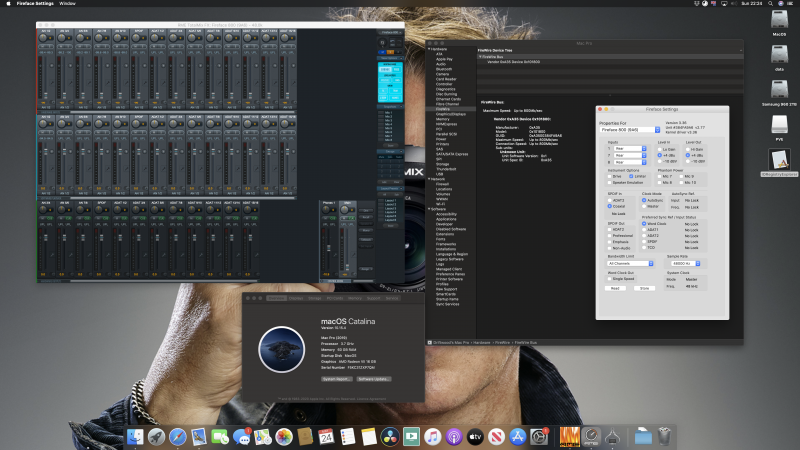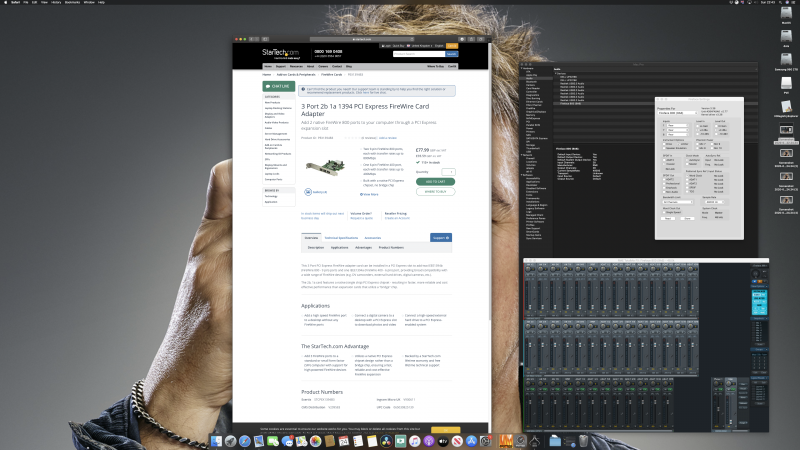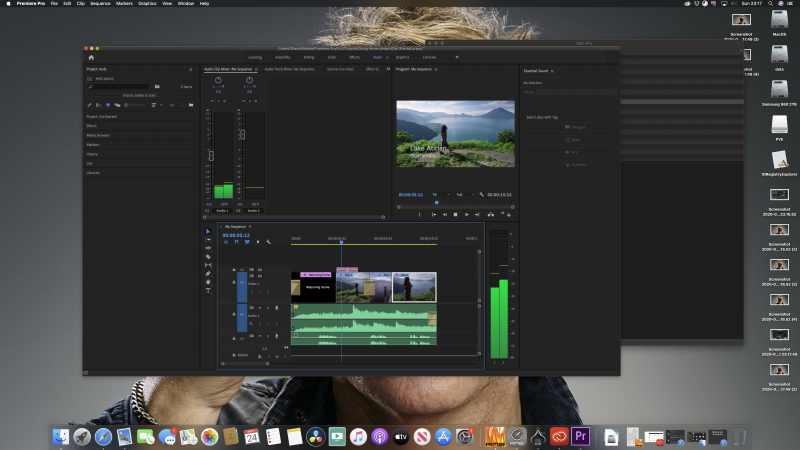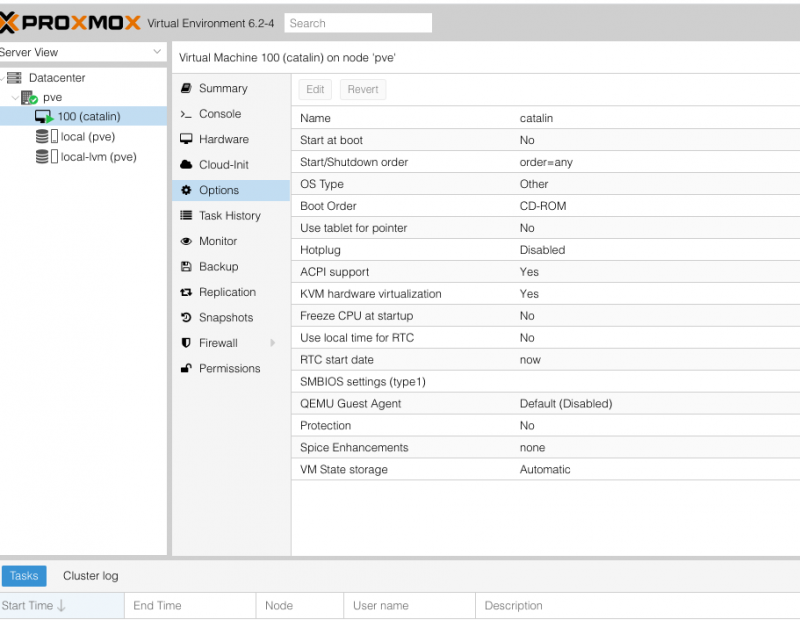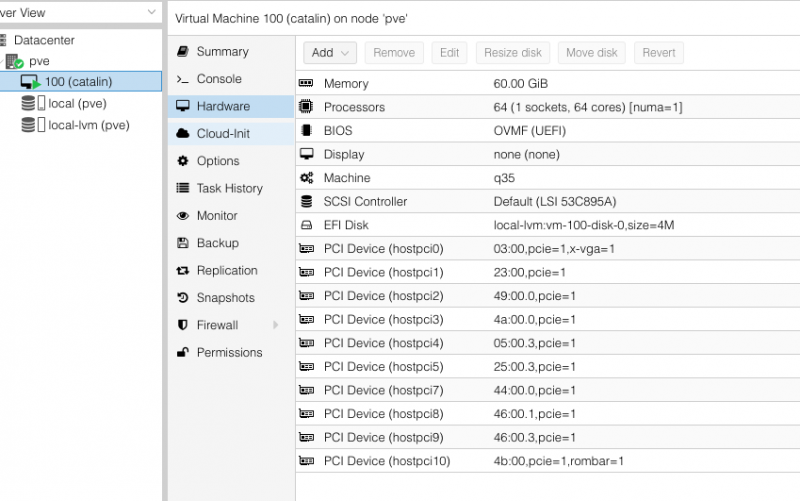
Driftwood
Members-
Posts
466 -
Joined
-
Last visited
-
Days Won
6
Content Type
Profiles
Forums
Events
Downloads
Everything posted by Driftwood
-
Nope. All good so far - pondering whether to switch in the SATA's now so I'll update you shortly. Even ran migration assistant on the USB-C rear in record time! 2TB done inside an hour - now you know how long MA normally takes, it waits around for ages checking things - its not really so much hard drive/net speed - its processing/checking off things. This was real quick. 8K Update: Managed to get the Dell 8K monitor working in 8K Catalina 10.15.5 with ResXtreme. My god it was soooo tiny that I had to scale.
-
That's Pavo's old system. He only just bought the msi. Expect an update from him when he gets the chance but he's busy trying to get audio working on the new trx40 msi mobo.
-
@Rox67er The two ASRock Creator SATA controllers (8 x SATA3 6.0 Gb/s) which, out of the two FCH address - 48:00 & 49:00 - is the first four? The reason I ask is I forget if you are booting proxmox from a SATA port or USB? I currently have Proxmox booting off SATA port 1 on a SSD. Im tempted to go USB (as @fabiosun has successfully done) but would prefer to boot with SATA from inside the box like Im doing. I currently don't passthrough either of the SATA controllers. I don't mind losing half the controllers to proxmox ssd, but which controller is using which IDs? Is 48:00 ports 1 - 4 ? And 49:00 Ports 5 - 8? I could do with using one of the controllers I guess.
-
You obviously check you had the right amount of cpu thermal grease on it?
-
I suspected that I might have to do this the other day when talking to Pavo. But after talking, I decided first to get the rear ASMedia USB controller passed through on 44:00 so I was able to use the rear 3.2 gen 2 port - couldn't use it before I passed it which is strange. So are you saying if you remove ALL USB controllers that the rear 3.2 gen 2 USB C connector works without passthrough? Ive actually ordered a Qnap TR4 NAS/Singles USB-C 3.2 gen 1box to stick my spinners in, which is 10Gbs. They also have this https://www.qnap.com/en-uk/product/tl-d800c coming out imminently giving support for USB 3.2 gen 2x2 speeds (20Gbs 8 drive box). So I might try and go back and un-passthrough the USB controllers/ports in my current config. And use the rear USB C too. Also I've got plenty of USB-C multi-port adapters from my MBP lappie so all is cool. Good confirmation, thanks Rox67er.
-
Good luck iGPU with the new cpu dude.
-
Hang on our shutdown error is GPU based of course... so... Which Radeon vii card u got? Looks like only the expensive Sapphire one is the only one which works properly in Mac/hax. Need to see if Sapphire ROM can be flashed to it in Windows. Did you try that already?
-
I experience the same problems as Rox67er on the reboot/shutdown issue - I often have to switch off, pull power and sometimes I might wait 10 seconds before repowering/reboot in. Basically the ASRock Creator seems to have problems with restart from Mac or a shutdown that the MSI board doesn't experience. Unless Fabiosun you have seen this too?
-
You mean SSDT?
-
Removed the BT kext...good thinking. The only thing I'm suffering is the Radeon Shutdown/restart problem. So it solves that?
-
There you go! Open Core stuff. Yeah the Matisse USB has been problematic. If you are getting what Im getting, avoid it. You're limited to 4 USB devices in Proxmox. So you may be able to pass through some off them. If you get success I'd like to know! I'd like to get my 3.2 gen 2s working 🙂 Currently the front USB stuff is knocked out and the bottom two USB 3 ports are too at the rear, plus the USB3.2s. Also its quite possible you have to get the r8125 Linux driver installed like I got as its more 'friendly' shall we say than Proxmox default driver which just seems hit and miss for this board. Another tip: Flash back to 1.50 fw on the bios, roll back your Proxmox install to an earlier than 6.2 and update later when you get in. 6.2 it appears is troublesome on install for us ASRock Creator users. When you're in correctly you can always flash back to 1.60. Ensure BIOS is set to defaults when you install (ie leave CMS alone for now), get boot order correct, etc. EFI.zip
-
Apologies @fabiosun. My mouse on an old Hack Mac running the host web console proxmox is faulty, I should have copied out to end of line! It is corrected now. I think the config is good for my case (because I use Decklink and Firewire pcie cards) but of course don't take things literally as other people's build / mobos are different. The ASRock Creator has come with a few headaches and I am keen in the future to see what other boards are out there - like the msi. Of course, when there's time for me, I will investigate further the problem with the other USB hub to see if we can knock that out of the equation as Im missing the 3 x USB 3.2 Gen2 (1 Front Type-C, 2 Rear) with this config. Apologies once again, I did not mean to offend you in any way. Thank you @Pavo for coming in to answer whilst I was afk.
-
I value this site more than anyone. I hardly know about Discord and not much Linux. Yourds was the first post I saw fabiosun so I want to say it was you who caught my eye first. I needed a fast video compression/editing machine for raw files first and foremost and didn't want to spend a fortune on a Mac so it was fab to see your post. The first 🙂 This thread ids great and I value all the guys here, most of all you. As I learn more about Proxmox and Linux in my free time I will be able to answer better. It won't take long as Ive learned a lot here, and with Pavo. This thread and group is wonderful I value what you say and the path of discovery. I tried to get all this kit working inside a week - spending unto 12 hours a day (sleeping at 5am!) to try and get this working. But to learn the knowledge of you and others will take me time. But Ill get there. I understand all the principles. After all, we all want our big investment to work for us. Its not just geekery stuff.
-
VM conf above VFIO conf below Thats my latest VM conf and VFIO conf. Noticed Ive now removed the other problematic USB, the Args line has the IRQ statement, and Ive ensured Proxmox is booting with at least 4Gb and have lowered RAM to 48Gigs until I get more RAM! Safety measure. The firewire and Decklink dont produce weird errors anymore like crackle and erratic mouse lag - now they just work! I think any one of those changes was responsible for problems. Ive also got monitor screen saver working without going black after coming back from its sleep. Hope this helps anyone. Pavo has been instrumental in getting this working and he clearly knows what he is doing, so rather than spend days sorting this (i understand more what he tells me all the time) I think advice from an expert is advise-able if you haven't got the time atm - got jobs on. I have to try that shutdown script @Roxer67 when I get the time. But my system is VERY stable now and Im very happy. It flies! ID 4d:00 and 4c:00 are the black magic Decklink and firewire cards
-
So here it is without the crackling - get rid of the nasty USB/USB audio controllers and viola - no more crackling. Spent an hour or two sorting this with Pavo. And he suspected the 47:00 Matisse USB 3 Controller was the culprit. Got rid of and now firewire has no crackle and mouse moves fluidly without lag. Also, in vm conf's 'Args' at the top, try kernel_irqchip=on, as this may have helped. Looking good to start using this beast now 🙂 Pic below showing 64 core/threads barely at work!
-
@Rocket88 Can you give me EXACT installation details below. Is cron part of Proxmox Debian? Do we need to install anything with 'Get' . Please type out exact method to install and how to copy it to snippets, when I run 'Crontab -e ' I get an editor, where do I go from there? Sorry Im a Linux noob!
-
Ah yes, I see the problem you describe @iGPU about the pci bridging. The card you have chosen to buy is the latest incarnation of mine (same chipset with extra port) Fingers crossed it works for you. Do you have RME audio like me? Ive discovered a problem. Everything works well in my setup until the monitor goes to screen saver. On return to desktop and relogging in to Mac I notice crackles and pops in audio and USB mouse is very jumpy. Any ideas what this could be? As if I have to reboot / switch off everytime just to use the Mac its really a lot of hassle! Ive tried changing from Rombar=1 or 0 with no difference so its not the firewire card, maybe its USB? Maybe its something I havent thought about. I have IOMMU set to enable in BIOS and CSM is disaabled (so is 4G for the sake of Proxmox) Update: even if i turn off screen saver and any type of sleep, this vm will begin to have slight crackles in audio playback and then laggy mouse...so if anyone has ideas? UPDATE2: All fixed now - dodgy USB controller with the sound HDAs on them. Disable them they're useless and interrupt everything else.
-
I have to admit I went through two different firewire cards before finding this one that worked @iGPU on my old regular hack Skylake Mac. So I already knew it should work in this vm.
-
Mobo: ASRock TRX40 Creator (good mid range board that is temperamental with ethernet Proxmox pickup on install. CPU: Ryzen 3970X. Fast and furious! RAM: 64GB Ram HyperX HX4361C17PB3K4/64 Predator 3600 Display: 2 x Radeon VII 16Gb GPU cards, 1st for Mac Apps. 2nd for Davinci/rendering packages m2/NVME: 2 x MP600 2TB nvme, 1 x Samsung 960 Pro nvme Video Capture: Black Magic Decklink 8K Pro Capture Card - Sets up well with BM Desktop Video Mac fw/drvr. Comes with 4 audio drivers too. Audio: Startech cheap Firewire Card for 2 x RME Fireface 800 audio boxes (classics!), Input: Corsair K65 and Corsair Mouse (iCue works) So my latest running build in vm Catalina. I guess the only thing I need to tune up now is USB. lspci -nnk VFIO.conf VM100.conf
-
Firewire StartechPEX1394B3LP with RME FIREFACE800 working with PCI passthrough on lane 2 in Catalina. Bottom pic, Premiere Pro working with Firewire 800. I don't fancy using the Realtek ADACS hence why I need pro cards to work in my box. But its good to know the Firewire works (and Adobe)
-
@Driftwood @Pavo maybe. Didn't go to him to for audio problems. Just that rogue nic. Ask him about it. It was trouble. It got to a point where it was beyond me and couldn't even get in. I even booted Windows on another drive to check. It found it in Deep Sleep. So I think I'd like to know what happens during an aborted prox install ? Proxmox shows a rollback of the nics if you watch, but what is going on here? It appears to fail the writeback to default dec ids for the realtek? It could well be that 6.2 straight install is the problem. I think after a failed install or abort this particular nic (the Realtek 8125G) just goes into deep sleep or just isn't supported 100% in by the included 8169 driver that proxmox uses for it? Who knows @fabiosun ?! I just needed to get on as have a big video edit to do and wanted to crack on so I got the experience of Pavo involved and he was a gent. As to the weird usb pcie loopback audio driver - I don't know whats going on - all I hear is hiss - but Im not in need of that as I use firewire devices and RME800s so wasnt so fussed. Pavo did give it a look and we checked over a couple of I/Os and it a sounded hissy... Ask Pavo I guess? Also Im a Discord noob (and Linux noob) Sometimes its quicker to just let someone with experience get on with it!
-
Keep a close eye on hardware dev/ids/IRQs changing order in lspci nnk when shifting devices around in the PCIe slots thats for sure! My Decklink re-install shifted from 4c:00 to 4d:00; and, after removing the unsupported wifi/bluetooth card (which occupied enp69s0) adding the Realtek 8125g driver, the Realktek now becomes enp69s0. So keep an eye on shifting sands :-) I'm now going to replace that Intel 6 Wifi/BT with a supported wifi bluetooth card). Wasted so many hours on this build looking for problems which were simply driver issues...!
-
@iGPU I had a bit of that during hardware installation with the Decklink card. This worked for me:- 1. Shutdown inside macOS like normal 2. ssh into the IP from your MacBook and type Qm stop 100 (ie your VM ID). 3. If no boot screen on reboot or freeze. the only option was to Power down, Switch off at back, pull the power chord, give it 5 secs, replug in power and switch back on - should restart without losing BIOS settings. Negated having to flash/cmos reset which just gets messy.
-
Okay, had a bit of a twiddle with that rogue nic on the ASRock Creator TRX40 board. Pavo took a look at it and totally sorted the problem. Even though I changed it in a post above, it was still going awol. Basically, the problem resides in the Realtek 8125 2.5g (the secondary nic in the mobo) and it goes missing sometimes (that's because it's using Proxmox's 'compatible' 8169 driver). The 'Atlantic' nic or (Aquantia) is always seen but you need to keep that unused for your passthrough OS as the Mac supports this nic. During my re-installs of Proxmox I never got the option for an IP home network address for the Realtek 8125g - when it was found it was providing only IPv6 mac addresses and gateway grief. The elegant (yet long-winded approach) method to overcome this problem is to grab hold of the Realtek 8125g driver from their site Realtek 8125g drvr - you'll find it under the Linux section. Bind that into your Debian/Proxmox install by ssh and re-edit / ifconfig it to become your default gateway nic. Its a bit tricky but with the massive help of the legendary Pavo he was able to sort it and viola! Everything is looking sweet now. With his top class authority we whipped thru the rest of the build and got everything working tip top. So Dual Radeon VIIs working, two MP600s, USBs, and a Black Magic Decklink 8K Pro all going very well. Messages works etc. Using 7,1 smbios in OpenCore with more tweaks from Pavo. Got a lot to think about but after installing my Firewire card (which should be a breeze as it already works in my HS Hack) we should be good to go. Top speed flyer... so all in all the Creator TRX40 from ASRock is not a bad budget board. Though I do like the look of the MSI with tons of m2 nvme reservations... tempted. PCI10 is the Black Magic Decklink. Notice you have to ROMbar=1 to get it working.
-
Exactly what I did on my old High Sierra Hack, and Ill be doing it on this too. Windows on a separate boot drive and F11 to boot it.




